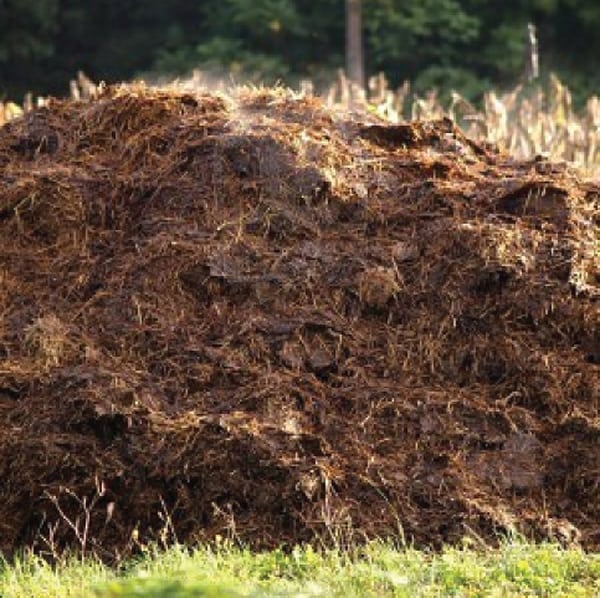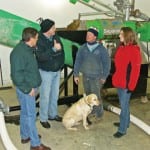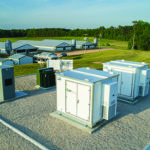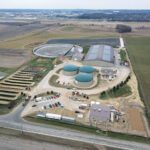Livestock animals in the U.S. produce more than one billion tons of manure annually (Figure 7). It’s a problem being surveyed critically by climate change advocates, because, according to standards developed by the Intergovernmental Panel on Climate Change, farm waste emits two potent greenhouse gases: methane, which has 21 times the global warming potential of carbon dioxide, and nitrous oxide, which has 310 times the warming potential of carbon dioxide over a 100-year timespan. Since a 2008 University of Texas-Austin study showed that converting farm animal droppings into renewable power could generate enough power to meet up to 3% of North America’s consumption, interest in cow power has been piling up.
 |
| 7. Like flies to manure. More farmers and communities are interested in generating renewable power from livestock manure, but a new study shows that the financial returns from generating electricity from cow dung may be highly dependent on several factors, among them: the base electricity price, the premium paid for converted energy, financial supports from government and other agencies, and the ability to sell by-products of the methane generation. Courtesy: University of Vermont |
According to the U.S. Environmental Protection Agency, as of September, 169 on-farm anaerobic digester systems were operating at livestock farms in the U.S. Of these, 151 systems (mostly at dairies), including 11 in Vermont, generated a total of 454,000 MWh of electricity annually. An average of 15 new digesters are expected to come online annually.
But a new study published in the Journal of Dairy Science suggests that the economics of converting cow dung into power on farms aren’t bullish. While researchers at the University of Vermont and Central Vermont Public Service Corp. (CVPS) confirm that it is technically feasible to generate electricity from cow manure, financial returns depend strongly on several factors, among them: the base electricity price, the premium paid for converted energy, financial supports from government and other agencies, and the ability to sell by-products of the methane generation.
The study analyzed six dairy farms that were participating in CVPS’s Cow Power Program over a seven-year period. (See “Central Vermont Public Service, Cow Power Program” in our December 2007 issue.) The program essentially helps farms plan and install anaerobic digesters and generators to generate electricity from manure, and markets the resulting power to its customers. As part of the program, dairy farms apply for grants from the corporation, the government, and other organizations, as well as use their own funds or bank loans, to install the necessary equipment.
More than 4,600 of CVPS’s 160,000 customers voluntarily agreed to pay a premium of $0.04/kWh over the regular retail price to buy 25%, 50%, or 100% of power generated from cow manure, paying $470,000 in premiums per year. The investor-owned utility reported that the six dairy farms generated about 12 million kWh annually, making it a “successful and locally sourced renewable energy project with many economic and environmental benefits,” said the study’s lead author Dr. Qingbin Wang, a professor in the Department of Community Development and Applied Economics, University of Vermont.
The study found that a dairy farm with an average milking herd size of 1,212 cows amassed 69 metric tons of manure that were fed to an anaerobic digester daily, producing 5,295 kWh. The digester produced revenues from electricity of about $958 per day (at $0.181/kWh) as well as fuel savings from capturing combustion heat for hot water and space heating. But one critically limiting factor the study found was that farms with 600 to 1,500 milking cows needed a huge average initial investment of about $2 million to plan the project, obtain permits, and build the digester—making grants and subsidies from the government indispensable.
The price farmers received for their electricity and revenue from by-products of the system were also important. Scenario analysis presented in the case study also suggests that relatively small changes in the premium price can have a significant impact on the cash flow of an average operation. Waste heat from biogas combustion, which can be captured and used on the farm, and by-products from the digester in the form of animal bedding and compost, contributed significantly to the farms’ cash flow—up to 26% of the total revenues in 2008.
Dr. Wang noted that the study was based on data from larger dairy farms and that most American dairy farms are smaller. More information is needed to determine whether cow power is technically and economically feasible for small farms, he said. He concluded, however, that “For any community interested in a locally sourced renewable energy project like the CVPS Cow Power Program, the strong commitment and collaboration of utilities, dairy farmers, electric customers, and government agencies at the state and local level is essential.”
The study—“Economic Feasibility of Converting Cow Manure to Electricity: A Case Study of the CVPS Cow Power Program in Vermont,” by Q. Wang, E. Thompson, R. Parsons, G. Rogers, and D. Dunn—can be found in the Journal of Dairy Science, vol. 94, no. 10 (October 2011).
—Sonal Patel is POWER’s senior writer










